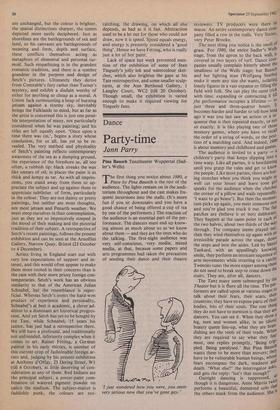Art
Fruits of battle
John McEwen
Merry Setch is 46. He is a Londoner 1 but since the late Sixties has lived in Wales, where he runs the painting depart- ment at Cardiff School of Art. Cardiff is only an hour and a half from London by train, but it might just as well be Port Stanley as far as the making of a reputation as a painter is concerned. Setch was begin- ning to be noticed when he left for Cardiff, but it was not till some of his huge, rough, encaustic and oil paintings on drapes of tarpaulin-type canvas were shown at the 1980 Hayward Annual, that he was `discovered'. Suddenly it was widely acknowledged that here was one of our best and most uncompromising painters. He was soon shown at the Serpentine Gallery; now he has his second one-man show at Nigel Greenwood Inc, 41 Sloane Gardens, SW1 (till 16 October), his new London gallery. It should not be missed.
Form and subject (junk on the sea shore) are unchanged, but the colour is brighter, the spatial distinctions sharper, the scenes depicted more easily deciphered. Just as shorelines are the battlegrounds of sea and land, so his canvases are battlegrounds of meaning and form, depth and surface, these conflicts themselves acting as metaphors of elemental and personal tur- moil. Such empathising is in the grandest romantic tradition, and there is a sombre grandeur in the purpose and design of Setch's pictures. Ultimately they derive from Constable's fury rather than Turner's mystery, and exhibit a disdain worthy of either for anything so cheap as a moral. A Union Jack surmounting a heap of burning jetsam against a stormy sky, inevitably brings the Falklands to mind, but as far as the artist is concerned this is just one possi- ble interpretation of many, not particularly considered when he was painting; and his titles are left equally open. 'Once upon a time there was Om', begins a story whose conclusion, for us all, has yet to be re- vealed. The very method and physicality of Setch's painting reflects contemporary awareness of the sea as a dumping ground, the experience of the foreshore as, all too often, a rubbish tip: black streaks the wax like smears of oil; in places the paint is as thick and lumpy as tar. As with all impres- sions, you stand away from them to ap- preciate the subject and up against them to appreciate subtleties of form, particularly in the colour. They are not dainty or pretty paintings, but neither are most thoughts, nor most jetsam and Penarth weather. We must steep ourselves in their contemplation, just as they are so impressively steeped in the mood of their making and the pictorial tradition of their subject. A retrospective of Setch's recent paintings, follows the present exhibition and can be seen at the Arnolfini Gallery, Narrow Quay, Bristol (23 October to 4 December).
Artists living in England start out with very low expectations of support and in- terest, and this would often appear to make them more rooted in their concerns than is the case with their more pricey foreign con- temporaries. Setch's work has an obvious similarity to that of the American Julian Schnabel, but the resemblance is super- ficial. Whereas Setch's seems the hard-won product of experience and personality, Schnabel's at best is academic, a clever ad- dition to a dominant art historical progres- sion. And yet Setch has yet to be bought by the Tate, while Schnabel, 15 years his junior, has just had a retrospective there. We still have a profound, and traditionally not unfounded, inferiority complex when it comes to art. Rainer Fetting, a German painter in his early thirties, is another of this current crop of fashionable foreign ar- tists and, judging by his present exhibition at Anthony d'Offay, 23 Dering Street, WI (till 6 October), as little deserving of con- sideration as any of them. Red Indians are the principal subject, a poster-paint com- bination of watered pigment powder on calico the medium. The subject-matter is faddishly punk, the colours are eye-
catching, the drawing, on which all else depends, as bad as it is fast. Abstraction used to be a let out for those who could not draw, now it is speed. Speed equals energy, and energy is presently considered a 'good thing'. Hence we have Fetting, who is really just a lot of hot paint.
Lack of space last week prevented men- tion of the exhibition of some of Jean Tinguely's jolly ink and watercolour sket- ches, which also brighten the gaps at his Tate restrospective, and some smaller sculp- tures, at the Ann Berthoud Gallery, 1 Langley Court, WC2 (till 20 October). Though small, the exhibition is varied enough to make it required viewing for Tinguely fans.



































 Previous page
Previous page